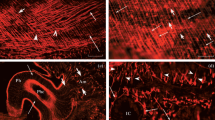Summary
Three neuronal systems of the pond snail Lymnaea stagnalis were immunocytochemically investigated at the ultrastructural level with the unlabeled peroxidase-antiperoxidase technique. Preliminary electrophysiological and cell-filling investigations have shown that a cluster of neurons which reacts positively with an antiserum against the molluscan cardio-active peptide FMRFamide, sends axons to the penis retractor muscle. In this muscle anti-FMRF-amide (aFM) positive axons form neuro-muscular synapses with (smooth) muscle fibers. The morphological observations suggest the aFM immunoreactive system to be involved in peptidergic neurotransmission. In the right parietal ganglion a large neuron (LYAC) is penetrated by aFM positive axons which form synapse-like structures (SLS) with the LYAC. The assumption that the SLS represent the morphological basis for peptidergic transmission is sustained by the observation that iontophoretical application of synthetic FMRFamide depolarizes the LYAC. The axons of a group of pedal anti-vasopressin (aVP) positive cells run in close vicinity to the cerebral ovulation (neuro-)-hormone producing cell system (CDC system) Synapses or SLS between the two systems were not observed. The fact that (bath) application of arg-vasopressin induces bursting in the CDC, may indicate that the vasopressin-like substance of the aVP cells is released non-synaptically.
Similar content being viewed by others
References
Boer HH, Groot C, Jong-Brink M de, Cornelisse CJ (1977) Polyploidy in the freshwater snail Lymnaea stagnalis (Gastropoda, Pulmonata). A cytophotometric analysis of the DNA in neurons and some other cell types. Neth J Zool 27:245–252
Boer HH, Schot LPC, Veenstra JA, Reichelt D (1980) Immunocytochemical identification of neural elements in the central nervous system of a snail, some insects, a fish and a mammal with an antiserum to the molluscan cardio-excitatory tetrapeptide FMRFamide. Cell Tissue Res 213:21–27
Boer HH, Schot LPC, Roubos EW, Maat A ter, Lodder JC, Reichelt D, Swaab DF (1979) ACTH-like immunoreactivity in two electrotonically coupled giant neurons in the pond snail Lymnaea stagnalis. Cell Tissue Res 202:231–240
Buijs RM, Swaab DF (1979) Immunoelectronmicroscopical demonstration of vasopressin and oxytocin synapses in the rat limbic system. Cell Tissue Res 204:355–367
Buma P, Roubos EW, Buijs RM (1984) Ultrastructural demonstration of non-synaptic release sites in the brain of the snail Lymnaea stagnalis, the insect Periplaneta americana, and the rat. Histochemistry 80:247–256
Cottrell GA, Schot LPC, Dockray GJ (1983) Identification and probable role of a single neurone containing the neuropeptide Helix FMRFamide. Nature 304:638–640
Maat A ter, Kits KS, Vlieger TA de (1980) Regulation of ovulation and oviposition in Lymnaea stagnalis: neurophysiological aspects of neurosecretion. Gen Comp Endocrinol 40:375
Plesch BEC (1977) An ultrastructural study of the innervation of the musculature of the pond snail Lymnaea stagnalis (L.) with reference to peripheral neurosecretion. Cell Tissue Res 183:353–369
Roubos EW (1984) Cytobiology of the ovulation-neurohormone producing neuroendocrine caudo-dorsal cells of Lymnaea stagnalis. Int Rev Cytol 89:295–346
Roubos EW, Moorer-Van Delft CM (1979) Synaptology of the central nervous system of the freshwater snail Lymnaea stagnalis (L.), with particular reference to neurosecretion. Cell Tissue Res 198:217–235
Roubos EW, Buma P, Roos WF de (1983) Ultrastructural correlates of electro tonic and neurochemical communication in Lymnaea stagnalis with particular reference to non-synaptic transmission and neuroendocrine cells. In: Lever J, Boer HH (eds) Molluscan neuro-endocrinology. Mon Roy Neth Acad Arts and Sciences. North Holland Publ Co, Amsterdam, Oxford, New York, pp 68–74
Schot LPC (1984) Immunocytochemical studies on peptidergic neurons in the pond snail Lymnaea stagnalis. PhD Thesis, Free University, Amsterdam, The Netherlands, pp 1–96
Schot LPC, Boer HH (1982) Immunocytochemical demonstration of peptidergic cells in the pond snail Lymnaea stagnalis with an antiserum to the molluscan cardioactive tetrapeptide FMRF amide. Cell Tissue Res 225:347–354
Schot LPC, Boer HH, Swaab DF, Noorden S van (1981) Immuno-cytochemical demonstration of peptidergic neurons in the central nervous system of the pond snail Lymnaea stagnalis with antisera raised to biologically active peptides of vertebrates. Cell Tissue Res 216:273–291
Schot LPC, Boer HH, Wijdenes J (1983) Localization of neurons innervating the heart of Lymnaea stagnalis studied immunocytochemically with anti-FMRFamide and anti-vasotocin. In: Lever J, Boer HH (eds) Molluscan neuro-endocrinology. Mon Roy Neth Acad Arts and Sciences. North Holland Publ Co, Amsterdam, Oxford, New York, pp 203–208
Swigchem H van (1979) On the endogenous bursting properties of “light yellow” neurosecretory cells in the freshwater snail Lymnaea stagnalis (L.). J Exp Biol 80:55–67
Swigchem H van (1981) Electrotonic coupling within a cluster of neurosecretory endogenous oscillators in Lymnaea stagnalis (L.). Comp Biochem Physiol 68A:199–209
Voorn P, Buijs RM (1983) An immuno-electronmicroscopical study comparing vasopressin, oxytocin, substance P and enkephalin containing nerve terminals in the nucleus of the solitary tract of the rat. Brain Res 270:169–173
Wendelaar Bonga SE (1970) Ultrastructure and histochemistry of neurosecretory cells and neurohaemal areas in the pond snail Lymnaea stagnalis (L.). Z Zellforsch 108:190–224
Author information
Authors and Affiliations
Rights and permissions
About this article
Cite this article
Boer, H.H., Schot, L.P.C., Reichelt, D. et al. Ultrastructural immunocytochemical evidence for peptidergic neurotransmission in the pond snail Lymnaea stagnalis . Cell Tissue Res. 238, 197–201 (1984). https://doi.org/10.1007/BF00215162
Accepted:
Issue Date:
DOI: https://doi.org/10.1007/BF00215162




